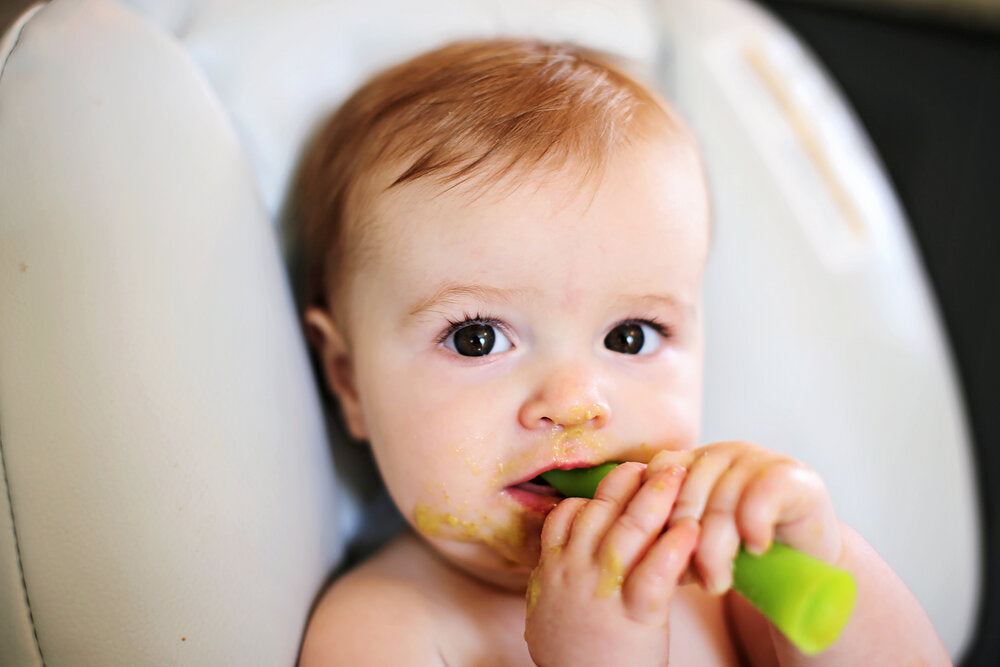Is your baby falling behind in feeding? Seeing your child not hit their developmental milestones especially when it comes to feeding can be extremely worrisome. While we won't cover all topics on feeding, one main culprit for a poor diet repertoire, is your babies inability to chew...

In this article we'll cover the top 5 tips for teaching your little one on how to chew and get ore accustomed to different foods! While these tips aren't exhaustive, they will lay the groundwork for your baby or infant as they learn how to chew. Whether your baby hasn't started to chew or you're transitioning them into eating solids, these tips will surely help you train to chew in your little one.
Using Teether Tubes
The teething stage for babies is filled with crying and fussiness, however, there comes a silver lining - your baby is learning how to chew naturally. This is the foundation for them to eat foods, not just from an oral motor standpoint, but from a sensory one as well.
Teether Tubes likes Lil' Foodie Chews are great teething options as they are long enough to reach the back molars, provide deep molar impact and encourage natural chewing patterns. Their sensory textures as well, help desensitize the mouth and reduce sensory aversions which oftentimes results in food refusals and ultimately picky eating habits.

Start feeding with Long & Large "Hand Foods"
Teethers can be hit and miss and you may find yourself trying to find the perfect one they'll gravitate too. Another alternative is to use long pieces of food that they can't eat but can teethe on.
Try options like long, peeled carrots or stalks of celery. Another baby hack is to dip these in baby food or puree to add an extra taste sensation to encourage mouthing & chewing!

Model how to chew!
Babies are absolute sponges when it comes to learning - simply eating at the table at the same time as your baby and modeling how to eat is recommended by feeding therapists across the board. Your baby is always watching you, and in their little brain of their's, they are analyzing how you chew and will want to imitate! When we say imitate, by the way, we mean EXAGGERATE your chewing patterns! Like literally grab a piece of food in your mouth, and chew with your mouth WIDE open - yes we know this is gross!
Brushing their Teeth
Brushing should become a habit early on, regardless if their teeth have cut through full. This may sound weird however, like Teether Tubes this is the perfect way to also provide sensory stimulation and oral motor patterns like chewing and tongue lateralization.
Tongue lateralization is important because while we chew, think about how we get food to make contact with our teeth. Yep, that's right, with our tongues! Therefore teether's and brushing can help babies map their mouths, crucial for chewing!

Feeding the Right Foods
Once your baby hits the 8-month mark, exposing your little one to a variety of foods with various textures is crucial.
The key here is a concept called exposure without expectation. Whether you place a graham cracker, or avocado puree with chunks, exposing your baby to these foods, regardless if they eat them, is the key. Continuous exposure to different textures will acclimate your child to these foods and eventually get them to feed and consequently map their mouths & chewing patterns!
Toddlers falling behind in feeding & chewing
Babies and toddlers can miss the window ideal for learning how to chew. While this can pose as a huge roadblock to healthy diets and healthy eating habits, just know it's never too late to teach them.
For one-year-olds and up, the tips given will still give a good foundation to learning how to chew. However, if you are a parent of a 12-month-old, and they are still nursing or eating purees, please do explore these tips and get started on teaching your little one how to chew!




Leave a comment: